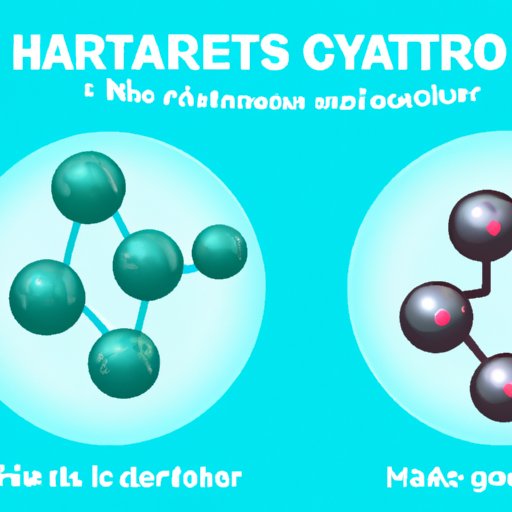Introduction
Water is the most abundant substance on Earth and plays a crucial role in all life forms. It is essential in many natural phenomena such as weather patterns, geological processes, and the survival of living organisms. One of the unique properties of water is its polarity, which is responsible for much of water’s behavior and is critical to many processes in nature. In this article, we will dive into the science of water molecules and explore why they are polar, their importance in chemical reactions, their crucial role in life processes, and their impact on weather patterns.
The Science of Water Molecules: Understanding Why They are Polar
Water is composed of two hydrogen atoms and one oxygen atom, forming a V-shaped molecule. The oxygen atom is larger than the hydrogen atoms and draws the electrons towards itself, creating a negative charge. This attracts the positively charged hydrogen atoms, creating a dipole moment and making the water molecule polar.
The polarity of water affects its behavior in various ways. For example, it allows water to dissolve polar molecules such as sugars, salts, and gases like oxygen and carbon dioxide. This property is vital for many biological processes such as transporting nutrients and removing waste. On the other hand, it also makes water a poor solvent for nonpolar substances like oil and fat.
The Importance of Polarity in Water Molecules and Its Role in Chemical Reactions
The polarity of water also plays a crucial role in chemical reactions. For example, polar molecules like ionic compounds dissolve in water because the water molecules can surround the charged particles, breaking them apart and forming hydration shells. This process is essential for many chemical reactions in living organisms, such as hydrolysis and photosynthesis.
Furthermore, the polarity of water affects the behavior of acids and bases. Water can act as both an acid and a base, depending on the situation. For example, in an acidic solution, water can accept a proton to become a hydronium ion, while in a basic solution, it can donate a proton to become a hydroxide ion. This property is critical in maintaining the pH balance in cells, blood, and other biological fluids.
Exploring the Hydrogen Bonding in Water Molecules: A Polar Perspective
Another unique property of water is its ability to form hydrogen bonds. Hydrogen bonds are a type of attraction between a hydrogen atom with a partial positive charge and an electronegative atom like oxygen or nitrogen. In the case of water, the partial positive hydrogen atoms attract the partial negative oxygen atoms of other water molecules and vice versa.
Hydrogen bonding contributes to many natural phenomena, including the high boiling point and surface tension of water. It also plays a significant role in transporting water in plants, capillary action, and ice formation. Hydrogen bonding is essential in the structure and function of proteins, DNA, and other biological molecules.
The Chemistry Behind Water’s Unique Properties: Polar Molecules and Their Effect on Life
The polarity of water plays a crucial role in many biological processes, including the transport of nutrients, regulation of body temperature, and maintenance of cell structure. Because water is polar, it can form hydration shells around biological molecules and help stabilize them. The unique properties of water also allow it to dissolve many ions and nutrients that are essential for life processes.
Another crucial role of water is its ability to act as a cushion, absorbing and dissipating mechanical forces in the body. The polar nature of water allows it to slide past other water molecules, reducing friction and minimizing damage to organs and tissues.
The Significance of Polarity in Water Molecules and Its Impact on Weather Patterns
The polarity of water also plays a crucial role in weather patterns. Water is a key component of the water cycle, where it evaporates from the surface and eventually forms clouds, which then precipitates as rain or snow. The polarity of water affects its ability to form hydrogen bonds, which allows many water molecules to stick together and form clouds.
Furthermore, the polarity of water affects its behavior in the atmosphere and contributes to various weather phenomena such as humidity, dew, and frost. It also affects the formation and strength of hurricanes and tornadoes.
Why Do Water Molecules Love to Stick Together? A Deep Dive into the Polar Nature of Water
The polarity of water also contributes to its strong cohesion and adhesion properties. Cohesion is the attraction between water molecules, while adhesion is the attraction between water molecules and other substances. The polarity of water allows it to form hydrogen bonds with other water molecules, resulting in a strong cohesive force.
Adhesion is crucial for water transport in plants, as it allows water to move upward against gravity via capillary action. Adhesion also allows water to stick to surfaces like glass and other materials, contributing to many natural phenomena such as dew, fog, and rainbows.
Conclusion
Water’s polarity is one of its most unique and essential properties. The dipole nature of water molecules is responsible for many of the natural phenomena and is critical to many biological processes. Understanding the polar behavior of water can help us better understand weather patterns, chemical reactions, cellular processes, and life as we know it. Overall, the importance of water’s polarity cannot be overstated, and its role in our world is truly remarkable.
